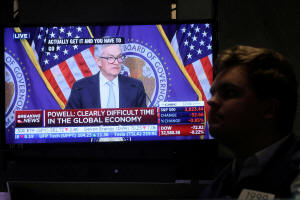Analysis-U.S. financial conditions have eased. So far the Fed is okay
with it
 Send a link to a friend
Send a link to a friend
 [December 10, 2022]
By Ann Saphir [December 10, 2022]
By Ann Saphir
(Reuters) - Over the past six weeks or so, U.S. mortgage rates have
fallen, stock prices are up, and yields on corporate debt have dropped,
all signs that financial conditions are easing even as the Federal
Reserve continues to wage war on 40-year-high inflation.
But unlike this past summer, when Fed Chair Jerome Powell pushed back
hard in the face of a similar set of market moves, U.S. central bankers
may this time be mostly okay with it.
The Fed next week is expected to slow what's been a blistering pace of
interest rate increases this year, with Powell telegraphing a
half-of-a-percentage point increase in the policy rate, to a range of
4.25%-4.5%.
The Fed raised rates by 75 basis points at each of its last four
meetings as it sought to lift borrowing costs high enough to bite into
economic growth.
Anticipation that December's smaller rate hike means the Fed is closer
to ending rate hikes altogether, along with data showing inflation may
be cooling and remarks from Powell that he and his colleagues "do not
want to overtighten," has fueled the recent easing in financial
conditions.
That's despite Powell and other policymakers repeatedly saying they are
not done raising rates, and won't be until they are convinced that
inflation, now running at 6% by the Fed's preferred gauge, is headed
down to the Fed's 2% goal.

Still, BNY Mellon Investment Management economist Sonia Meskin said,
"they don't appear to me as concerned about the loosening of financial
conditions" as they were in the summer, when rate hikes had only just
begun.
"I would expect him to reiterate that they're going to keep policy
restrictive for some time, but I don't think he is likely to say
anything beyond that, and the reason is, they actually want to keep
their options open," she said.
The Fed will likely need to raise the policy rate "somewhat higher" than
the 4.6% policymakers projected in September, Powell said late last
month.
Fresh projections by Fed policymakers released after next week's meeting
are expected to reflect that, along with a forecast for no cuts to the
policy rate until 2024.
CONSUMER, BUSINESS BORROWING COSTS EASE
But inflation data or readings on the labor market could come in lower
than expected, allowing the Fed to lean into the easing in financial
conditions and stopping rate hikes at a lower point than otherwise.
Or things could get worse, perhaps because labor supply constraints
continue to feed higher wages and push up on inflation, a possibility
Powell nodded to in recent remarks and could reprise next week.
[to top of second column] |

A screen displays Federal Reserve Chair
Jerome Powell speaking as a trader works on the floor of the New
York Stock Exchange (NYSE) in New York City, U.S., November 2, 2022.
REUTERS/Brendan McDermid/File Photo

There is also uncertainty over how tight policy actually is.
Researchers at the San Francisco Fed recently tried to capture the
effect of the Fed's forward guidance and reductions to its balance
sheet, and concluded that monetary policy is actually tighter now
than the Fed funds rate suggests.
That could feed into arguments that the economy and labor markets
are poised to weaken next year, easing inflation pressures.
Some economists do expect Powell to continue to emphasize the risks
of not doing enough to fight inflation rather than about going too
far, with a rise in unemployment a painful but necessary part of the
process.
"The Fed wants financial market conditions to be tighter," said
Oxford Economics' Ryan Sweet, because that is how the Fed slows the
economy and brings down inflation, a process that will likely also
include an increase in unemployment. "They are getting a little
frustrated."
The average 30-year fixed rate loan for residential housing, which
rose to more than 7% in October from about 3% a year earlier,
dropped to about 6.3% in the most recent week. Yields on the
riskiest corporate debt have fallen to about 8.6% from about 9.6% in
mid-October. And those drops came despite the Fed lifting its policy
rate by three-quarters-of-a-percentage point, to 3.75%-4% in early
November.
Meanwhile, unemployment has stayed at a low 3.7%, below where Fed
policymakers had thought it would be as tighter policy slowed the
economy.
Part of the reason the Fed may be more comfortable with easing
financial conditions now than in the summer is simply that the Fed
has already raised interest rates by nearly 4 percentage points.

It expects the effects of those higher borrowing costs on the
economy as a whole to take a while yet to kick in.
"As much as they would love to not have a premature easing of
financial conditions, the cost of that back then was a lot higher
then than it is now," said Morgan Stanley Investment Management's
Eric Stein. "They are a lot closer to where they need to go."
(Reporting by Ann Saphir in Berkeley, Calif.; Editing by Dan Burns
and Nick Zieminski)
[© 2022 Thomson Reuters. All rights
reserved.]
This material may not be published,
broadcast, rewritten or redistributed.
Thompson Reuters is solely responsible for this content. |